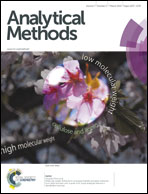Comparison of the volatile profile of vine-shoots and oak chips by headspace-gas chromatography-mass spectrometry (HS-GC-MS)†
Abstract
Profiling and identification analysis of the volatile fraction formed by heating vine-shoots or oak chips powder have been obtained by headspace-gas chromatography-mass spectrometry (HS-GC-MS). For this purpose, vine-shoots collected from eighteen varieties of vineyards and five types of oak chips have been heated at different temperatures in a headspace autosampler to compare the volatile compounds formed from both types of wood. This strategy allowed obtaining a representative profile of volatile compounds from each sample. Multivariate statistical analysis of the resulting data by application of Venn diagrams and principal component analysis showed the strong influence of temperature on the composition of the volatile compounds obtained from vine-shoots and oak chips. Finally, identification of the compounds in the volatile fraction of vine-shoots and tested oak chips was carried out. The main families of compounds have been identified as a function of both the heating temperature and the type of wood. Semiquantitative analysis of compounds with oenological interest in the volatile fraction formed by heating vine-shoots and oak chips was used to evaluate similarities and differences between both materials.


 Please wait while we load your content...
Please wait while we load your content...